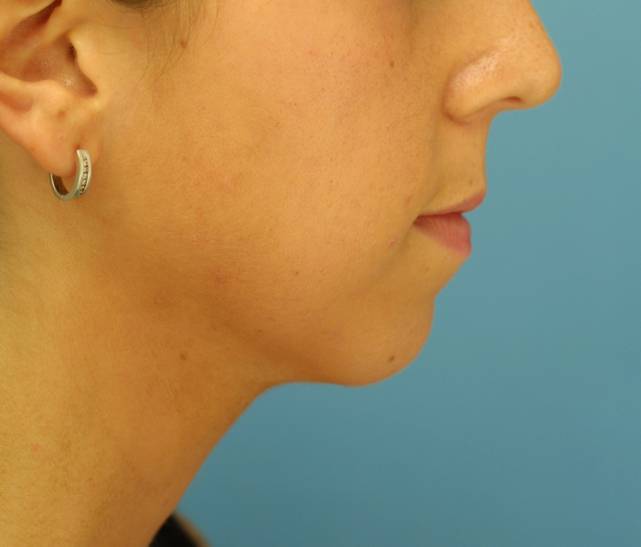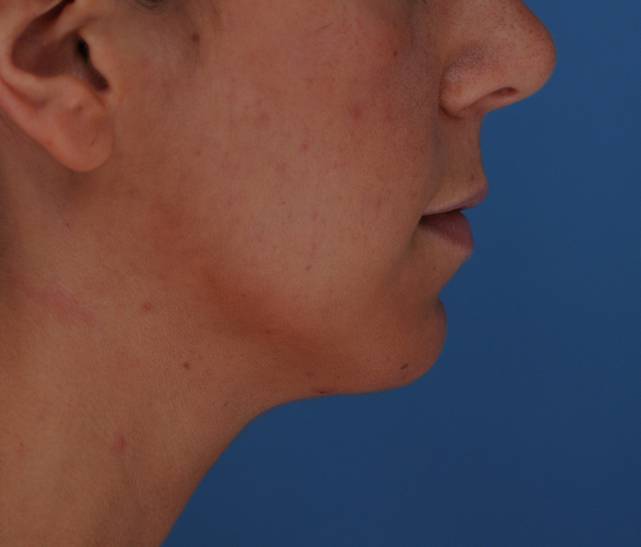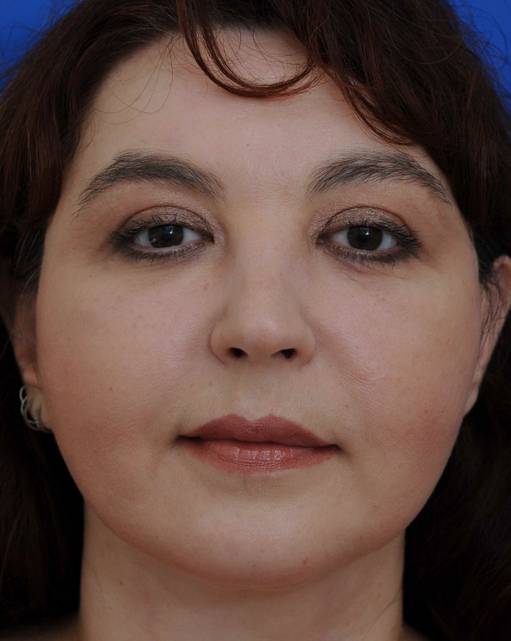

Chin Augmentation
The chin is a major factor in the symmetry and proportion of the face. Chin augmentation surgery (also called Mentoplasty, Genioplasty or chin implant surgery) is a procedure to improve the appearance of the chin or jaw line area. Depending on other facial characteristics, such as the nose, forehead, and cheeks, the chin can be enlarged using a chin implant or reshaped to achieve an aesthetically pleasing and balanced facial profile.
Before and After Chin Implant Surgery
View Chin Augmentation Photo Gallery
What can chin augmentation accomplish?
Chin augmentation can reshape the chin to make a more aesthetically pleasing and symmetrical facial profile. Because the chin is a major focal point of the face, chin augmentation procedures can dramatically change the appearance of the entire face. Chin enhancement surgery utilizes a chin implant to add volume to patients who have unsymmetrical facial profiles due to having a “weak chin” and prominent other features.
What is the difference between surgical and non-surgical chin augmentation?
There are both surgical and non-surgical chin augmentation treatment options available.
Surgical chin augmentation, commonly referred to as chin implant surgery (also called Mentoplasty or Genioplasty), utilizes a medical implant to increase the size of the chin. Surgical chin augmentation via a chin implant provides dramatic and permanent results. However, chin implant surgery is more invasive and a period of downtime is required.
Non-surgical chin augmentation uses specialized dermal fillers such as Juvederm Volux to enhance the chin. Non-surgical chin augmentation is minimally invasive, does not require incisions to be made, and patients can return to normal daily activity immediately following injection. Treatment consists of the targeted injection of a specialized dermal filler close to the bone to enhance the structure of the lower jaw and chin area. Chin augmentation via fillers provides a moderate result that is temporary, but can be extended with periodic maintenance treatments.
Double Chin Treatments
There are several effective treatments (both surgical and non-surgical in nature) to address submental fullness under the chin (i.e., double chin). These options remove the isolated pocket of excess fat under the chin, providing a smooth contour to the chin and jawline. Treatment options for double chin removal include Kybella, CoolSculpting, and Liposuction.
Surgical Chin Augmentation via Chin Implants
How is chin implant surgery performed?
Depending on the preference of the patient and surgeon, chin implant surgery can be performed with general, local, or twilight anesthesia. The surgeon makes an incision, either outside or inside the mouth, to create a pocket below the muscle and above the chin bone. Next the chin implant is placed and secured with sutures. Sutures are used to close the surgical incision.
On average, chin augmentation surgery takes 1-2 hours depending on the specifics of each individual procedure.
What are chin implants made from?
Typically, chin implants are made from either gortex, silastic (solid silicone) or medpore. Silicone chin implants are currently the most used as they are very effective and safe. Ultimately the type of chin implant used depends on the surgeon’s preference, patient’s medical history, and desired results.
Who is an ideal candidate for chin implants?
Chin implants are ideal for overall health individuals who are unhappy with the shape or proportion of their chin and its effect on their overall facial appearance, and who wish to achieve a dramatic and permanent result.
What can I expect after undergoing chin implant surgery?
For 2-3 days after chin augmentation surgery, you may have to wear a protective brace over your chin. Bruising, swelling and minor pain may also be present but subsides after a couple of days. You may experience some numbness in the chin area which usually subsides after a couple of weeks.
Most patients can resume light activity the same day of the surgery and be able to return to work and usual activities within 7-10 days of the procedure. Due to the significant change in appearance, it may take several weeks for patients to fully get used to their new look.
Can chin implants be used in conjunction with other plastic surgery procedures?
It’s fairly common for a surgeon to recommend performing the chin augmentation alongside other procedures including rhinoplasty, facelift surgery, facial liposuction, and/or lip augmentation. The combination of procedures allows a plastic surgeon to create the desired amount of facial symmetry.
Meet Our Plastic Surgeons
- Daniela Atencio, MD (Downtown Austin)
- Minas Constantinides, MD, FACS (Lamar Central)
- Cameron Craven, MD, FACS (Westlake)
- Timothy McGee, MD (Round Rock)
Non-Surgical Chin Augmentation via Dermal Fillers
How is a chin filler treatment performed?
Filler-based chin augmentation procedures are quick and relatively painless. Treatment begins with the application of a topical numbing cream to the chin in order to minimize discomfort. Next, a skilled injector will inject a dermal filler into targeted areas along the chin. Patients can return to work and normal activity immediately following treatment.
What results can non-surgical chin augmentation provide?
While typically providing a less dramatic result than chin implants, filler-based chin augmentation can add a moderate amount of volume into targeted areas of the chin and jawline for a natural-looking result. This can improve the proportion of the chin, enhance overall facial symmetry, create a more defined look to the jawline, and minimize the prominence of jowls or folds in the lower face area.
Are chin filler results permanent?
Like other dermal filler treatments, chin fillers do not provide a permanent result. Result duration can range between 9 to 18 months depending on the unique traits of each patient and the type of filler used. Maintenance treatment sessions performed every 9-12 months can prolong results over the long term.
Is Downtime required?
No major downtime (recovery time) is required, patients can return to most daily activity immediately following treatment. Post-injection, some patients may experience redness or bruising around injection sites, which will resolve after a few days. Strenuous activity including vigorous exercise can typically resume 3 days after treatment. Many injectors will also recommend patients limit touching their face or applying pressure to the jawline for up to 2 weeks following injection.
Are The Injections Painful?
Chin filler treatments are minimally painful as topical numbing cream can be utilized and injections are made utilizing an ultra-fine needle. Some fillers like Juvederm Volux also contain lidocaine, which works to numb the skin during injection. While some patients may experience minor to moderate swelling or tightness post injection, discomfort typically ceases within 24-48 hours of injection.
Who is a good candidate for non-surgical chin augmentation?
Ideal candidates for chin fillers are healthy individuals who wish to enhance their chin or jawline without the pain or downtime of surgery. The treatment is ideal for patients seeking a natural-looking result. Since results are not permanent, chin fillers are a great option for those are considering chin implants but are unsure about how they will affect their look or lifestyle.
 Before
Before  After
After  Before
Before  After
After